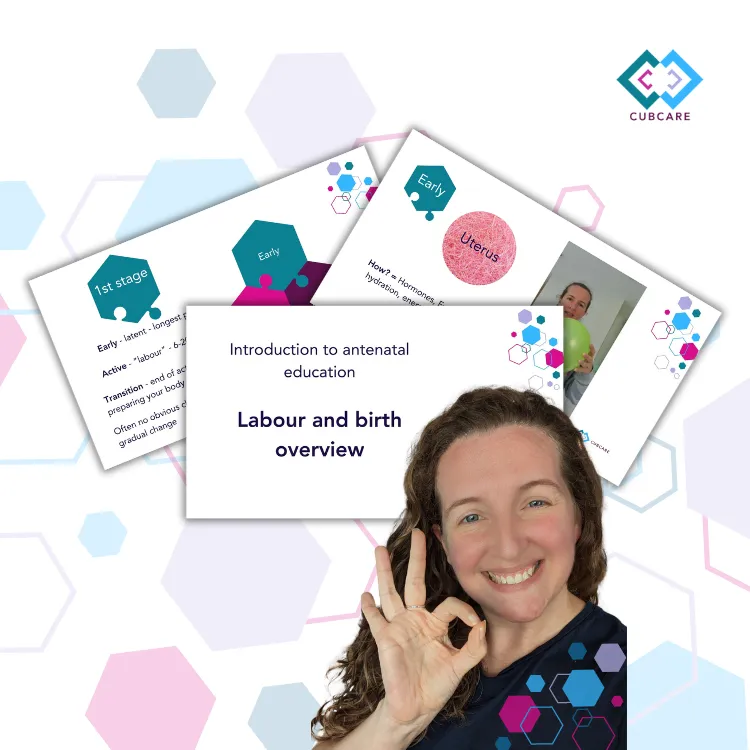We're an award winning Antenatal and Postnatal Education Platform 2025!
(read more here)
CubCare blogs.
From early pregnancy to newborn development.
Advice to help through pregnancy, birth and childhood.
BLOG

How to push a baby out effectively?
"As I always ask in my antenatal classes, you could have a longer labour with less active effort that could lead to exhaustion, or a shorter, more physically tiring labour.
Although there are never any guarantees, or hard and fast rules - birth is a relationship between you, baby and the situation. " - Jilly Clarke
How do you push a baby out?
When it comes to giving birth, watch any film or television programme or read any sensationalist newspaper article and you will come across the same thing.
Firstly, the medical professional, or in some extreme circumstances the birth partner, is deemed the hero for safely delivering the baby.
Does this not contrast with our knowledge of giving birth? The knowledge that we know that people can give birth vaginally whilst in a coma. That the human body is perfectly capable and successful at giving birth without a doctor or coaching team taking all the credit? Without them actively doing very much at all?
Secondly, a coach (either medical professional or birth partner) sets about instructing the person in labour to push at directed intervals.
The picture is always, somebody deems it is time, an instruction is given to get on your back. Then tucking your chin to your chest, tightening your abs, pulling back your knees, taking a deep breath, holding it and pushing towards your bottom for a count of 10. Before bearing down in this manner two or three times during each contraction.

Isn't a Doctor supposed to tell you to push?
This is what is called “coached” or guided pushing.
To suggest this for everybody is unnecessary and could possibly lead to issues. As if someone giving birth, despite doing the work of labour themselves rather successfully up to this point, is unable to do the last bit of labour without external instruction.
If there is no reason to interfere, there is no need to get involved with the instincts of the birthing person.
For most people, when the reach fully dilated there is no urge to push for a while. We know that delayed pushing (a delayed second stage) for around an hour, or until there is an urge to push can, according to several studies including this 2024 review of the available evidence, "produce at least the same maternity outcomes as immediate pushing...a shorter duration of the active pushing and a tendency to increase spontaneous vaginal birth and to reduce the instrumental vaginal birth rates and fatigue scores."
Whilst being exhausting, holding your breath, tensing your muscles, and pushing with all your might could have a negative impact on you and baby. Whilst guided pushing can result in a shorter second stage of labour, the actively pushing phase is shorter for those who use spontaneous pushing. Maternal outcomes using delayed pushing versus immediate pushing in the second stage of labour: An umbrella review - ScienceDirect
As I always ask in my antenatal classes, you could have a longer labour with less active effort that could lead to exhaustion, or a shorter, more physically tiring labour.
Although there are never any guarantees, or hard and fast rules - birth is a relationship between you, baby and the situation.

What is spontaneously pushing baby out and how to do it?
Relaxing muscles
Breathing, relaxing muscles, and keeping the oxygen flowing is important at this final stage before delivery. Making the process easier and less stressful for everyone. Continuing to listen to your body and staying relaxed and open as you may well have been doing during labour up to now.
Keeping your jaw, pelvic floor and stomach muscles relaxed you give baby the most room to move down and find their position. Letting your body do what it naturally wants to do will produce much less stress for you and will likely result in an easier time for baby.
Keep breathing
All you have to do is breathe and your uterus will do its job of expelling the baby earthside. If you feel the need to give some assistance, then direct the oxygen downwards – feel your abdomen moving downwards with each exhale, adding an extra force to your uterus bearing down too.
Just as the uterus will have done its hard work up until this point, it will continue to work as it needs to until baby is safely delivered.
Listen to your body
Each person will feel their contractions and urges differently, and even as baby moves down all contractions may result in different urges.
Spontaneous pushes tend to occur in shorter but more recurrent bursts during contractions. As the baby lowers and exerts greater pressure on your pelvic floor, you may begin to push harder and more frequently during contractions. People who aren’t being instructed usually let a contraction grow before putting pressure – very much like the urge to do a poo…it is a very similar process.
Make noise
You will most likely make noise, so it makes sense to try and harness it for a purpose.
Try this now:
Make a high-pitched sound and notice where you feel this most in your body.
Most likely it will come from your throat and back of your mouth. Everything from your throat to your tummy will feel tense and tight, and the energy is moving out and away from your body.
Now try making a low mooing sound.
What differences can you feel? This time your throat feels open, your diaphragm moves, and your tummy feels relaxed.
Which one feels positive?
Even if you don’t feel the urge to make noise during your birth, follow the same principles of keeping everything low, relaxed and sent downwards towards baby.
Also do the same when you're sitting on the toilet - it is the same release and relaxation of the pelvic floor muscles! It's much easier on your pelvic floor.
Want to know more important tips for confidently approaching labour and birth? Check out my weekly classes or antenatal workshops.
Refresher Antenatal Course in person
Refresher Antenatal Course online
Birth Partner course (included in our Antenatal course)
Antenatal Course in person
Antenatal Course online
Easily navigate to our most popular Blog categories
Download our Freebies

Labour and Birth
Watch our introduction to antenatal education webinar, our labour and birth overview - to start your antenatal education journey. Understanding the process, and what you can do to influence it.

Pregnancy Planner
Free Pregnancy Planner to help you prepare for a little one. Prepare your body, your mind, your finances and your home. Get organised, feel good and prepare for an active, positive birth.

Birth Partner Guide
Your ultimate guide to being the best birth partner during pregnancy, birth and recovery. Learn what you need to do, and what you need to learn to be the best birth partner possible.

Expecting Again Guide
Your ultimate guide to preparing for another birth and an extra baby. Our top tips for navigating pregnancy and birth, and helping your older ones to transition into their new role as a big sibling.
Based in Welwyn Hatfield, offering local pregnancy support and doula services across Hertfordshire: St Albans, Hatfield, Welwyn Garden City, Potters Bar, Stevenage, Harpenden, Hitchin, Barnet, Mill Hill and surrounding areas.
Online antenatal and postnatal education available UK-wide.
© Copyright 2025 CubCare The Parenting Hub. CubCare is operated by The Birth and Baby Company Ltd. Company No. 15655287
Privacy Policy | Terms & Conditions | Medical Disclaimer | Inclusivity and Accessibility

